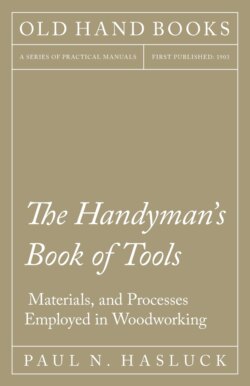Читать книгу The Handyman's Book of Tools, Materials, and Processes Employed in Woodworking - Paul N. Hasluck - Страница 79
На сайте Литреса книга снята с продажи.
IMPROVEMENTS IN PLANE CUTTING IRONS.
ОглавлениеMuch time is lost in grinding and sharpening plane irons of the thickness to which they are made at the present time. It is only the thin steel face of the iron that requires a keen edge; yet to obtain this a waste of time is incurred, owing to the amount of metal that must be removed at the back of the edge. Now if a thin steel cutter could be introduced to place between the two irons, it would do away with the grindstone altogether for sharpening planes. This idea is not by any means new, and it has been practically carried out, both with hand and machine tools, with marked success. Fig. 203 shows this principle applied to an ordinary plane iron; Fig. 203 shows the back and fore iron, between the two being the thin steel cutter, shown separately by Fig. 204. Cutters of this description could be produced at half the cost of ordinary plane irons, if made in any quantity. Grinding a plane iron is a dirty job, even under the most favourable circumstances, and it is thought that a cutter that does away with it is bound to meet with success.
Fig. 205.—Grinding Gouge.
Fig. 206.—Grinding Gouge.
Fig. 207.—Sharpening Gouge on Oilstone.
Fig. 208.—Sharpening Gouge with Oilstone Slip.
Fig. 209.—Two Pieces of Wood Scribed Together.
